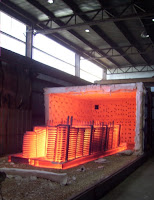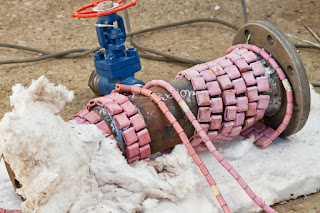609-588-0900
A blog that provides educational information on electric heating systems used on hoppers, chutes, tanks and vessels; electric heating systems used for pre and post weld heat treating; heat treating power consoles; custom heat treating furnaces; and single & multi-operator welders. For more information, visit HotfoilEHS.com
Hotfoil-EHS Manufacturing and Distribution Facilities
Hotfoil-EHS, Inc. is an organization with over 70 employees and an impressive engineering capability. Through continued re-investment of profits, Hotfoil-EHS acquired additional large fabrication facilities and today is a full-service engineering, design, and manufacturing company of industrial heating equipment. Their Hamilton, NJ headquarters provides 68,000-square-feet of manufacturing space, with other manufacturing and distribution facilities located in Chattanooga, TN, LaPorte, TX, and Birmingham, England.
The Importance of Post-weld Heat Treatment for Welding Repairs
Welding is the process of melting two metals together. During the welding process, the metal is exposed to very high temperatures and undergoes a phase change, first from solid to liquid, then back to solid as it cools.
During welding, residual stresses are formed in an area referred to as "the heat affected zone" or HAZ. In the HAZ, differential contractions occur as the metal heats, liquifies and then cools to ambient.
Residual stresses have a significant impact on the performance of a weld and their reduction is highly desirable. The undesirable impact of residual stresses in welded metal structures involve fatigue performance and corrosion resistance.
Welding repairs are increasingly a structural integrity concern for aging equipment such as pressure vessels, piping systems and other large steel systems. The make up of residual stresses near repair welds can be drastically different from those residual stresses of the original weld. Post-weld heat treatment (PWHT) is used to reduce residual stress in steel and and should be used for welding repairs ( as well as on new welds).
PWHT is proven very effective in reduction of high residual stress around the weld repair. Conventional PWHT can be done by combustion furnace, induction heaters or electric resistance heaters (ceramic pad heaters). Accurate ramp and soak times, as well as data recording can be done with modern power console systems. It is strongly recommended to apply PWHT for all original and repair welds.
During welding, residual stresses are formed in an area referred to as "the heat affected zone" or HAZ. In the HAZ, differential contractions occur as the metal heats, liquifies and then cools to ambient.
Residual stresses have a significant impact on the performance of a weld and their reduction is highly desirable. The undesirable impact of residual stresses in welded metal structures involve fatigue performance and corrosion resistance.
 |
| Heat treatment furnace. |
 |
| PWHT with resistance heaters |
PWHT is proven very effective in reduction of high residual stress around the weld repair. Conventional PWHT can be done by combustion furnace, induction heaters or electric resistance heaters (ceramic pad heaters). Accurate ramp and soak times, as well as data recording can be done with modern power console systems. It is strongly recommended to apply PWHT for all original and repair welds.
What Are External Electric Tank Heaters?
 External Electric Tank Heaters: Eliminate Concerns about Material Compatibility and High Watt Densities when Dealing with Viscous, Aggressive, or Erosive Contents
External Electric Tank Heaters: Eliminate Concerns about Material Compatibility and High Watt Densities when Dealing with Viscous, Aggressive, or Erosive Contents
Many industries use large fiberglass or steel tanks that need to be heated. A common way to heat the tank contents is with electric heating elements designed to penetrate the tank through an existing flanged or threaded opening. This type of heating element, known as an immersion heater, is put directly in to the process media and heats the tank contents. While this heating method is efficient, it's not alway practical. Some tanks contain very viscous, chemically aggressive, or physically erosive media. Using an immersion heater for these applications gets tricky. Very careful consideration needs to be taken when determining proper watt density, maximum sheath temperatures, and material compatibility.
Another way to electrically heat steel or fiberglass tanks is with externally mounted "pad" heaters, also known as heater panels. This type of heating element is mounted directly to the exterior tank surface and provides evenly distributed heating over a large area of the tank. These heaters are designed to deliver the required amount of energy (watts) distributed over a larger surface area, and provide "gentle" heating that will not burn or react with the process media. Furthermore, since heating panels are mounted externally, there's no concern with corrosion or erosion from aggressive or abrasive contents.

External electric panel heaters are constructed of flat foil based heating elements or nichrome resistance wire patterns sandwiched between flexible and tough silicone or fiberglass layers. Because of the heating element pattern, even distribution of heat is assured with no hot spots. Panel heaters come in many standard sizes, volts and wattages. Custom shape and sizes are available too for tanks with complex geometries. Installation is easy and requires no special tools or skills. Heaters are usually installed by banding them to the tank with metal bands or polyester straps, which takes only a matter of minutes.
For optimal performance and greatest energy savings, external panel heaters should be insulated to minimize backside loses. The job of the insulation is to direct the majority of the heating panels energy into the tank. Failure to insulate allows for heat energy to escape to the surrounding area.
For tank heating applications where immersion heater sheath temperatures, or sheath material compatibility is a concern, or where penetrating the tank is impractical, externally mounted electric heating panels are an excellent solutions.
Custom Heat Treatment Furnaces Designed for the Most Challenging Applications
Hotfoil-EHS is a New Jersey based company who will design and fabricate custom heat treatment furnaces. From small, low-throughput furnaces, to high yield furnaces, to rail-driven furnaces designed to move back and forth over the materials being heated, Hotfoil-EHS has done it all.
From decades of experience in furnace production, many important furnace engineering discoveries were made that save time, money, and improve the end product.
Contact Hotfoil-EHS for your next heat treatment furnace requirement.
https://hotfoilehs.com
609-588-0900
From decades of experience in furnace production, many important furnace engineering discoveries were made that save time, money, and improve the end product.
Contact Hotfoil-EHS for your next heat treatment furnace requirement.
https://hotfoilehs.com
609-588-0900
American Made Heat Treatment Equipment: Everything You Need from One Reliable and Knowledgeable Source
Hotfoil-EHS manufactures pre and post-weld heat treating equipment including: power consoles; ceramic mat heaters; thermocouple attachment units (TAUs); pin welders; Brinell testers; Poldi hardness testers; thermocouple wire; insulation; and accessories.
EHS engineers, designs, and manufactures proven systems to effectively complete any project more efficiently than competitive systems, while staying competitive within any budget. Years of application experience and successful installation history have produced thousands of happy customers. Quality and durability at an affordable price, and a focus on customer service second to none.
EHS engineers, designs, and manufactures proven systems to effectively complete any project more efficiently than competitive systems, while staying competitive within any budget. Years of application experience and successful installation history have produced thousands of happy customers. Quality and durability at an affordable price, and a focus on customer service second to none.
Electric Heating 101: Ohms Law
V = i R
Resistance is a circuit property that offers opposition to the flow of electrons through a wire. It is analogous to friction in a mechanical system. The resistance is measured in ohms and depends on the geometry of the resistor and the material used in the resistor.
Other manipulations of Ohms Law:
Pre Weld and Post Weld Heat Treatment
 |
| Welding between insulated heating areas Heating done by ceramic heaters (pink). |
An industry standard means of accurately managing the pre-heat and post-weld heat treatment is through the use of specialized electric heaters. Electric welding preheaters, known as "ceramic mat heaters", are rugged and flexible heating elements designed so that they conform uniformly around the weld and surrounding area. Ceramic mat heaters are normally controlled by a power console that uses thermocouples and electronic controllers to regulate, monitor, and many times record, the preheat temperature profile.
 |
| Ceramic heaters on spool piece. |
Before deciding to preheat or post heat any welding job, consult with a heat treating expert to make sure proper welding code requirements are being followed.
Subscribe to:
Comments (Atom)



